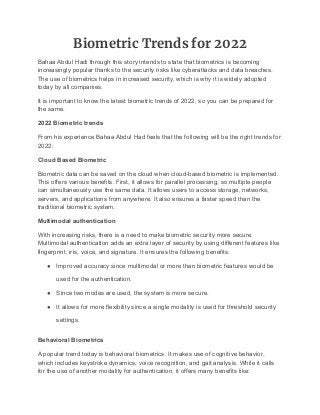
Biometric Trends for 2022 - Bahaa Abdul Hadi.pdf
- 1. Biometric Trends for 2022 Bahaa Abdul Hadi through this story intends to state that biometrics is becoming increasingly popular thanks to the security risks like cyberattacks and data breaches. The use of biometrics helps in increased security, which is why it is widely adopted today by all companies. It is important to know the latest biometric trends of 2022, so you can be prepared for the same. 2022 Biometric trends From his experience Bahaa Abdul Had feels that the following will be the right trends for 2022: Cloud Based Biometric Biometric data can be saved on the cloud when cloud-based biometric is implemented. This offers various benefits. First, it allows for parallel processing, so multiple people can simultaneously use the same data. It allows users to access storage, networks, servers, and applications from anywhere. It also ensures a faster speed than the traditional biometric system. Multimodal authentication With increasing risks, there is a need to make biometric security more secure. Multimodal authentication adds an extra layer of security by using different features like fingerprint, iris, voice, and signature. It ensures the following benefits: ● Improved accuracy since multimodal or more than biometric features would be used for the authentication. ● Since two modes are used, the system is more secure. ● It allows for more flexibility since a single modality is used for threshold security settings. Behavioral Biometrics A popular trend today is behavioral biometrics. It makes use of cognitive behavior, which includes keystroke dynamics, voice recognition, and gait analysis. While it calls for the use of another modality for authentication, it offers many benefits like:
- 2. ● Background passive verification. ● Helps in improved user privacy. ● Allows passive enrolment of users by websites. Biometric trends in different industries Biometric authentication is being used increasingly in different sectors. Earlier the banking sector was the first to use biometrics. Today, it has become common and is used in different sectors. Bahaa Abdul Hadi shares his observations from different industries as stated below: Finance and Banking The use of biometric authentication will increase in the banking and financial sector. While earlier, only the fingerprint was used for authentication, today companies are using multifactor authentication for enhanced security. More effort is needed in this area, since security risks are increasing every day. Healthcare Hospitals and healthcare institutions are using fingerprint and iris scanners to authenticate patient identity. The use of biometrics enables medical staff to conveniently access patient medical records Law enforcement Law enforcement agencies are increasingly using biometrics to identification. Biometrics of convicted persons are being used to create a database that would be helpful in effective law enforcement. Apart from fingerprints, DNA, iris patterns, and speech recognition is also being used. Thank you for your time. Bahaa Abdul Hadi
